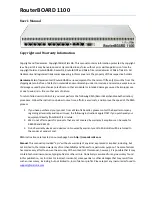
8
boot device
– initial boot device (boot over Ethernet | boot from NAND, if fail then Ethernet | boot from
CompactFlash only | boot Ethernet once, then NAND | boot Ethernet first, then CompactFlash | boot from
NAND only;
boot from NAND, if fail then Ethernet
by default). You can also select
boot chosen device
option
to boot from the device selected immediately, without saving the setting.
reset configuration
– whether to reset all the boot loader settings to their respective default values (yes | no;
no
by default).
format nand
– perform a low-level NAND format. During this operation, all previously marked bad sectors are
retested to find out if they are faulty indeed.
upgrade firmware
– receive a new boot loader image using XModem protocol over serial line or using
DHCP/BOOTP and TFTP protocols through the Ethernet network (upgrade firmware over ethernet | upgrade
firmware over serial port).
board info
– prints the serial number, boot loader version, CPU frequency, memory size and MAC addresses of
the onboard Ethernet ports
boot protocol
– network booting protocol (bootp protocol | dhcp protocol;
bootp protocol
by default).
do memory testing
– performs a full memory test.
cpu-frequency
-
a
-
MEM:333DDR
CPU:333MHz
b
-
MEM:333DDR
CPU:500MHz
c
-
MEM:333DDR
CPU:667MHz
d
-
MEM:333DDR
CPU:833MHz
e
-
MEM:400DDR
CPU:400MHz
f
-
MEM:400DDR
CPU:600MHz
g
-
MEM:400DDR
CPU:800MHz
h
-
MEM:400DDR
CPU:1000MHz
i
-
MEM:533DDR
CPU:533MHz
*j
-
MEM:533DDR
CPU:800MHz
k
-
MEM:533DDR
CPU:1067MHz
l - MEM:533DDR CPU:1333MHz
Boot Loader Upgrading
The boot loader is needed to initialize all the hardware and boot the system up. Newer loader versions might
have support for more hardware, so it's generally a good idea to upgrade the loader once a newer version is
available.
The boot loader upgrading is possible from MikroTik RouterOS, from within the “/system routerboard” menu.
Updates are included with each RouterOS update. The procedure is described in the MikroTik RouterOS
manual: http://wiki.mikrotik.com/wiki/Manual:Bootloader_upgrade
You can also upgrade the loader through the onboard serial port using XModem protocol (programs available
for all major OSs). For example, you can use HyperTerminal for Windows or Minicom for Linux to upload the
boot loader. Alternatively if you have a DHCP/BOOTP and TFTP servers available, you can specify the loader
image as a boot image and choose the
bios upgrade over ethernet
option in the boot loader configuration
menu. The loader will get the image from the TFTP server and upgrade itself. The most current loader image is
available for download on www.routerboard.com.





























